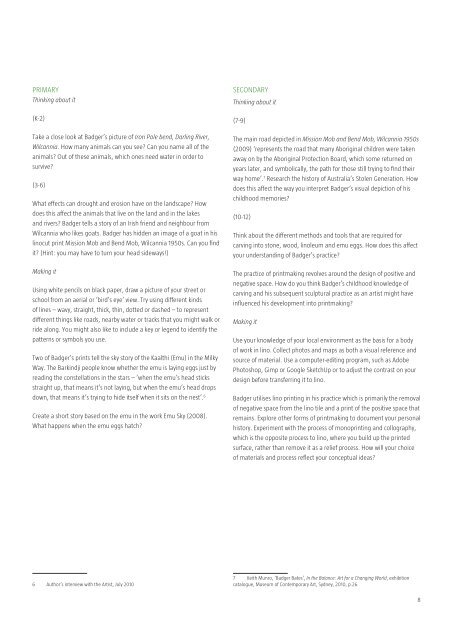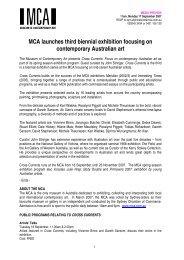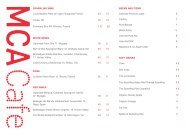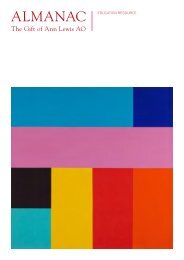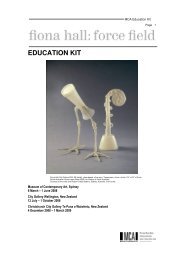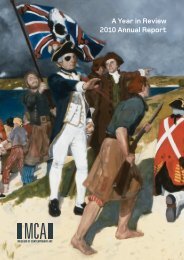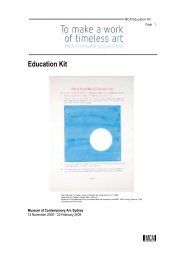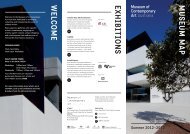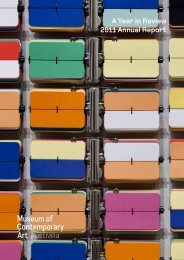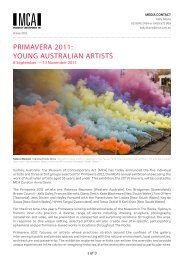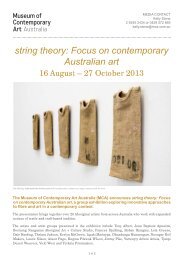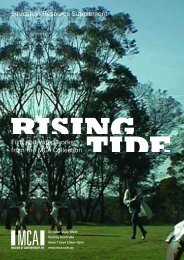Download - Museum of Contemporary Art
Download - Museum of Contemporary Art
Download - Museum of Contemporary Art
Create successful ePaper yourself
Turn your PDF publications into a flip-book with our unique Google optimized e-Paper software.
PRIMARY<br />
Thinking about it<br />
(K-2)<br />
Take a close look at Badger’s picture <strong>of</strong> Iron Pole bend, Darling River,<br />
Wilcannia. How many animals can you see Can you name all <strong>of</strong> the<br />
animals Out <strong>of</strong> these animals, which ones need water in order to<br />
survive<br />
(3-6)<br />
What effects can drought and erosion have on the landscape How<br />
does this affect the animals that live on the land and in the lakes<br />
and rivers Badger tells a story <strong>of</strong> an Irish friend and neighbour from<br />
Wilcannia who likes goats. Badger has hidden an image <strong>of</strong> a goat in his<br />
linocut print Mission Mob and Bend Mob, Wilcannia 1950s. Can you find<br />
it (Hint: you may have to turn your head sideways!)<br />
Making it<br />
Using white pencils on black paper, draw a picture <strong>of</strong> your street or<br />
school from an aerial or ‘bird’s eye’ view. Try using different kinds<br />
<strong>of</strong> lines – wavy, straight, thick, thin, dotted or dashed – to represent<br />
different things like roads, nearby water or tracks that you might walk or<br />
ride along. You might also like to include a key or legend to identify the<br />
patterns or symbols you use.<br />
Two <strong>of</strong> Badger’s prints tell the sky story <strong>of</strong> the Kaalthi (Emu) in the Milky<br />
Way. The Barkindji people know whether the emu is laying eggs just by<br />
reading the constellations in the stars – ‘when the emu’s head sticks<br />
straight up, that means it’s not laying, but when the emu’s head drops<br />
down, that means it’s trying to hide itself when it sits on the nest’. 6<br />
Create a short story based on the emu in the work Emu Sky (2008).<br />
What happens when the emu eggs hatch<br />
SECONDARY<br />
Thinking about it<br />
(7-9)<br />
The main road depicted in Mission Mob and Bend Mob, Wilcannia 1950s<br />
(2009) ‘represents the road that many Aboriginal children were taken<br />
away on by the Aboriginal Protection Board, which some returned on<br />
years later, and symbolically, the path for those still trying to find their<br />
way home’. 7 Research the history <strong>of</strong> Australia’s Stolen Generation. How<br />
does this affect the way you interpret Badger’s visual depiction <strong>of</strong> his<br />
childhood memories<br />
(10-12)<br />
Think about the different methods and tools that are required for<br />
carving into stone, wood, linoleum and emu eggs. How does this affect<br />
your understanding <strong>of</strong> Badger’s practice<br />
The practice <strong>of</strong> printmaking revolves around the design <strong>of</strong> positive and<br />
negative space. How do you think Badger’s childhood knowledge <strong>of</strong><br />
carving and his subsequent sculptural practice as an artist might have<br />
influenced his development into printmaking<br />
Making it<br />
Use your knowledge <strong>of</strong> your local environment as the basis for a body<br />
<strong>of</strong> work in lino. Collect photos and maps as both a visual reference and<br />
source <strong>of</strong> material. Use a computer-editing program, such as Adobe<br />
Photoshop, Gimp or Google SketchUp or to adjust the contrast on your<br />
design before transferring it to lino.<br />
Badger utilises lino printing in his practice which is primarily the removal<br />
<strong>of</strong> negative space from the lino tile and a print <strong>of</strong> the positive space that<br />
remains. Explore other forms <strong>of</strong> printmaking to document your personal<br />
history. Experiment with the process <strong>of</strong> monoprinting and collography,<br />
which is the opposite process to lino, where you build up the printed<br />
surface, rather than remove it as a relief process. How will your choice<br />
<strong>of</strong> materials and process reflect your conceptual ideas<br />
6 Author’s interview with the <strong>Art</strong>ist, July 2010<br />
7 Keith Munro, ‘Badger Bates’, In the Balance: <strong>Art</strong> for a Changing World, exhibition<br />
catalogue, <strong>Museum</strong> <strong>of</strong> <strong>Contemporary</strong> <strong>Art</strong>, Sydney, 2010, p.26<br />
8


